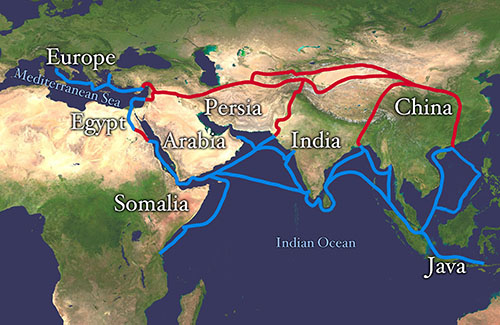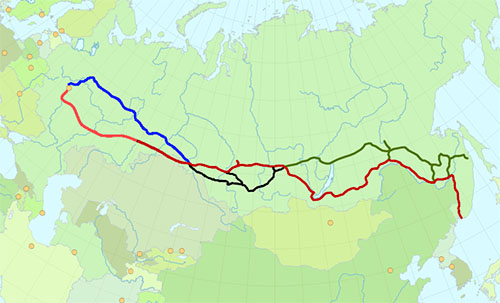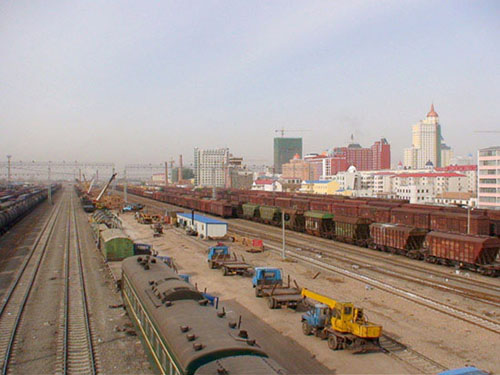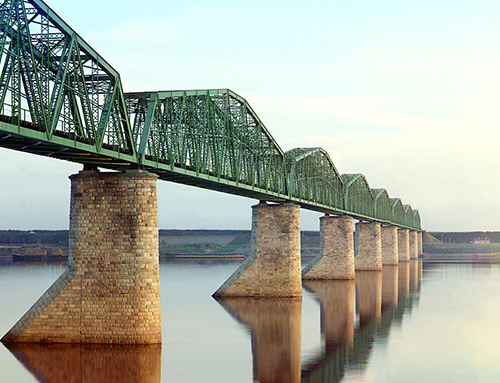

 STUART JORDAN looks at the revival of this ancient trade route by rail.
STUART JORDAN looks at the revival of this ancient trade route by rail.
The Silk Road was an ancient trading route which connected Europe with far-flung places in South-East Asia as well as China. The origins of the route began around 200BC, with silk and other goods being traded west from China along both land and maritime routes to the Mediterranean for many centuries. With the advances in merchant shipping technology and a shift to routes through the Persian Gulf rather than round Africa, coupled with territory changes in Central Asia, the overland Silk Road collapsed in the 1700s.

Routes of the original Silk Road
These days, we think of shipments of goods coming from China on massive container ships. Although this is the norm, there has been progress to re-open the overland trade routes from China, through the Middle East and Central Asia to Russia and Europe.

Trans-Siberian Railway (marked in red)
The first rail-link between Europe and the Pacific was the Trans-Siberian Railway, which was completed in 1916. It is the longest rail line in the world, running for 9,200km between Moscow and Vladivostok. The Trans-Siberian can currently handle up to 200,000 containers’ worth of freight in a year, although interest in using the line had dwindled by the 1990s. Russia lowered the tariffs on freight, which led to an increase of goods from the Far East being transported to European ports in Scandinavia, as well as components from Germany and Poland being carried in the other direction to Chinese factories.
The Trans-Mongolian Railway links the Trans-Siberian to the Chinese city of Jinning, by way of the Mongolian capital Ulaanbaatar. Like all lines which cross between China and Russia, there is a change of gauge. China uses Standard Gauge (4ft 8½in) whereas Russia (and Mongolia) uses a broad gauge (4ft 1127⁄32in). This means that all trains either must have the goods transferred to a different train in the correct gauge, or more commonly the bogies are changed. This can lead to lengthy delays as each piece of rolling stock is lifted in turn. Variable gauge axles have been considered, but the cost of retrofitting existing stock would be immense.
Kazakhstan has become an important part of this Eurasian Land Bridge, with rail links to the Trans-Siberian and European Russia. Sitting in-between Russia and China, the latter has included Kazakhstan in their One Belt, One Road Initiative (later renamed Belt & Road Initiative) to develop a strategy of improving infrastructure on routes between China and the West.

Manzhouli, on the border between Russia and Mongolia
Announced in 2013 the strategy will include three links across the Silk Road Economic Belt, including integration with Kazakhstan’s own infrastructure improvement initiative as part of the New Eurasian Land Bridge. This scheme is also looking at alternative routes, including freight running to the Persian Gulf via Iran or through the Marmaray tunnel in Turkey, with a Chinese freight train testing the route in November 2019. This route also includes a break in gauge, as it passes through Kazakhstan, Uzbekistan, and Tajikistan who all use Russian Gauge.
Also, part of this project is rail links to Western Europe. Freight routes from the Chinese freight hub of Yiwu now link with Madrid and London. These now make up the longest and second longest rail routes, respectively. Because Spain uses Iberian Gauge (5ft 521⁄32in) the train has to be re-gauged when entering Kazakhstan, Poland, and Spain. The London route travels through the Channel Tunnel to Barking. This is a route that Gaugemaster are utilising, with our Prodigy controllers due to come by train in January 2020. Travel time takes 18 days, compared to 30-45 days that a container ship may take. Spain exports olive oil back to China, and the UK are looking at products which could be exported in this way.

The rail bridge over Kama River at Perm, Russia
With rail links from China to Germany and the Netherlands, as well as the prospect of a high-speed passenger link between China and Western Europe, the Silk Road is definitely back in business.
You can find a variety of Russian and Chinese railway products on our site, but you won’t need to change the bogies!